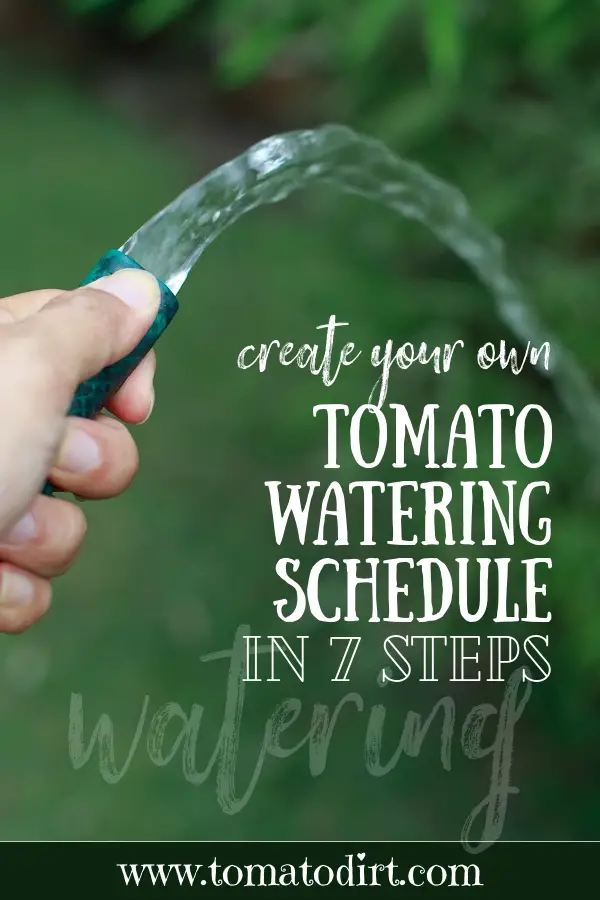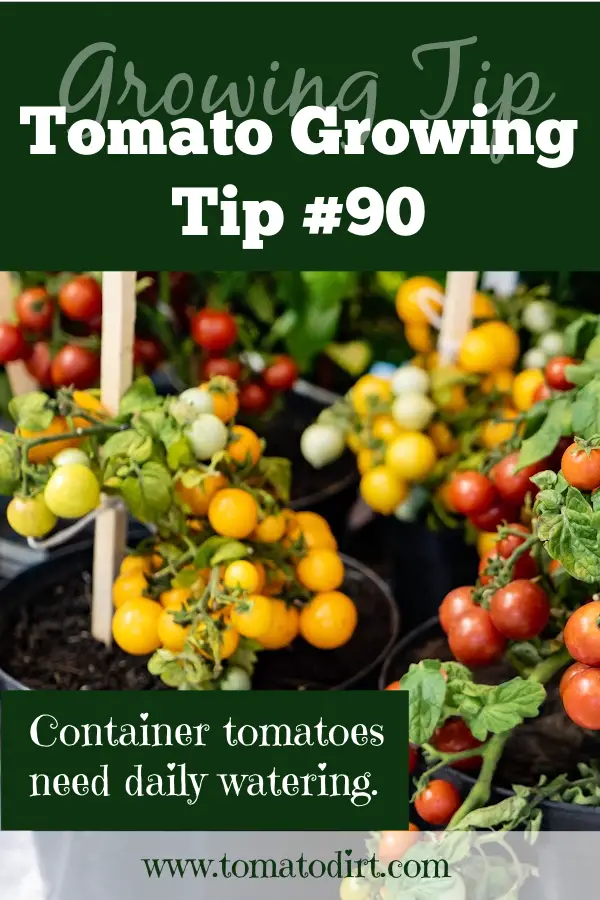FREE: 10 Must-Know Tomato Growing Tips Get The Guide
Read our affiliate disclosure here.
How to Create a Tomato Watering Schedule
Since 2010, Tomato Dirt has garnered 4.8+ million views, making it the web’s leading online source for growing tomatoes in the home garden. Award-winning writer and Tomato Dirt owner Kathy Widenhouse has helped thousands of home gardeners grow healthier tomatoes. Be one of them when you get Tomato Dirt’s Growing Guide here.
Updated 7.19.25
Every garden is different. What works in your tomato patch may not fly for your neighbor just two doors down. That’s why you need to create your own tomato watering schedule.
If you want healthy, productive tomato plants, then proper watering is crucial. When you put together a tomato watering schedule and follow it, your plants receive consistent moisture, which is key to avoiding issues like blossom-end rot and splitting fruit. Plus, they will continue to produce plenty of fruit throughout the season.
In contrast, inconsistent watering can lead to parched tomato plants, leaving them wilted with small fruit. Or too much water can drown plants’ root systems. Overwatering causes root rot and a host of fungal diseases, which are not pretty.
And if you ignore the weather, you’ve got another set of problems. Even if you have your watering system on a timer, tomato plants are at the mercy of the elements. You need to adjust for heat waves and rainy periods.
Here’s the dirt: you need a plan. Follow these detailed steps to develop your own tomato watering schedule tailored to your garden's needs.
Step 1: Assess your growing conditions
Evaluate soil type and composition
- Sandy soil: Drains quickly and requires more frequent watering.
- Clay soil: Retains moisture longer and may need less frequent watering.
- Loamy soil: Ideal for tomato plants, offering balanced drainage and moisture retention.
Determine your planting method
- In the ground: Soil can retain moisture, so water more deeply but less frequently.
- In raised beds: Soil drains faster and may require more frequent watering.
- Containers/pots: Soil dries out quickly and often needs daily watering.
Step 2: Monitor soil moisture levels
Use a moisture meter
- Insert the probe into the soil near the root zone to check moisture levels.
- Aim to keep the soil consistently moist, but not waterlogged.
Perform the finger test
- Stick your finger into the soil up to your second knuckle (about 2 inches deep).
- If the soil feels dry at that depth, it’s time to water.
Step 3: Understand your plants’ needs
and growth stages
For seedlings and young plants
- Young tomato plants require less water than mature plants but need consistent moisture to establish roots.
- Water gently and frequently to keep the soil evenly moist.
For mature, fruiting plants
- Need more water, especially when setting fruit.
- Ensure deep watering to support fruit development and avoid blossom end rot.
Step 4: Factor in weather conditions
In hot, dry weather
- Increase watering frequency to compensate for higher evaporation and transpiration rates.
- Water deeply every 2-3 days or more often if the heat is extreme.
In cool, humid weather
- Reduce watering frequency as the soil will retain moisture longer.
- Monitor for signs of overwatering, such as yellowing leaves and fungal growth.
Step 5: Set a baseline watering
schedule
For ground-planted tomatoes
- Water deeply once a week, providing about 1-2 inches of water each time.
- Water every 3-5 days, adjusting based on weather and soil moisture levels.
- Water daily, or even twice a day during hot weather.
- Monitor closely and water as needed, usually every 2-3 days.
Step 6: Adjust your tomato watering
schedule depending upon plant health and growth
Track plant responses
- Observe your plants for signs of water stress (wilting, yellowing leaves) or overwatering (fungal growth, waterlogged soil).
- Adjust your watering schedule accordingly.
Record and review
- Keep a gardening journal to note your watering schedule, weather conditions, and plant health.
- Review your notes regularly to identify patterns and make adjustments.
Step 7: Implement advanced watering
techniques
Mulching
- About 2-3 weeks after planting, apply a 2-3 inch layer of organic mulch (straw, shredded leaves) around your plants. By waiting, you allow soil to warm on its own.
- Mulch helps retain soil moisture, regulate temperature, and reduce weeds.
Drip irrigation or soaker hoses
- Install a drip irrigation system or soaker hoses to deliver consistent moisture directly to the root zone.
- Use a water timer to automate watering and maintain consistency.
Self-watering containers
- Use self-watering containers to provide a steady supply of moisture to container-grown tomatoes.
- Ensure the reservoir is filled regularly.
Extra tips for your tomato watering
schedule
- Water early or late: Water your plants early in the morning or late in the evening to reduce evaporation.
- Avoid overhead watering: Water at the base of the plants to keep leaves dry and reduce disease risk.
- Monitor and adapt: Stay vigilant and be ready to adapt your schedule based on changing conditions and plant needs.
Follow these steps and you'll create a personalized tomato watering schedule that keeps your plants healthy and productive throughout the growing season.
More on Watering Tomato Plants
Watering tomatoes: Frequently Asked Questions (FAQs) ...
Techniques for watering tomato plants ...
How Often Do You Water Tomato Plants?
How to water tomatoes in containers, pots, and baskets ...
Are you watering tomatoes enough?
How to choose a garden hose for watering tomatoes ...
Watering gadgets: which ones do you need for growing tomatoes?
Get more ideas on our Watering Tomatoes Pinterest board...
Return from Create Your Own Tomato Watering Schedule to Tomato Dirt home
As an Amazon Associate and Rakuten Advertising affiliate I earn from qualifying purchases.
SHARE THIS PAGE:
FREE! 10 Must-Know Tomato Growing Tips: 20-page guide
Get yours here:





